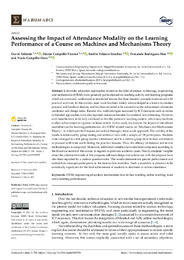Please use this identifier to cite or link to this item:
https://hdl.handle.net/11000/31157Full metadata record
| DC Field | Value | Language |
|---|---|---|
| dc.contributor.author | Campello Vicente, Héctor | - |
| dc.contributor.author | Campillo Davo, Nuria | - |
| dc.contributor.author | Valiente, David | - |
| dc.contributor.author | Velasco Sánchez, Emilio | - |
| dc.contributor.author | Rodríguez Mas, Fernando | - |
| dc.contributor.other | Departamentos de la UMH::Ingeniería Mecánica y Energía | es_ES |
| dc.date.accessioned | 2024-02-06T12:24:07Z | - |
| dc.date.available | 2024-02-06T12:24:07Z | - |
| dc.date.created | 2021 | - |
| dc.identifier.citation | Mathematics 2021, 9(5) | es_ES |
| dc.identifier.issn | 2227-7390 | - |
| dc.identifier.uri | https://hdl.handle.net/11000/31157 | - |
| dc.description.abstract | University education approaches related to the field of science, technology, engineering and mathematics (STEM), have generally particularized on teaching activity and learning programs which are commonly understood as reoriented lessons that fuse theoretic concepts interweaved with practical activities. In this context, team work has been widely acknowledged as a means to conduct practical and hands-on lessons, and has been revealed to be successful in the achievement of exercise resolution and design tasks. Besides this, methodologies sustained by ICT resources such as online or blended approaches, have also reported numerous benefits for students’ active learning. However, such benefits have to be fully validated within the particular teaching context, which may facilitate student achievement to a greater or lesser extent. In this work, we analyze the impact of attendance modalities on the learning performance of a STEM-related course on “Machines and Mechanisms Theory”, in which practical lessons are tackled through a team work approach. The validity of the results is reinforced by group testing and statistical tests with a sample of 128 participants. Students were arranged in a test group (online attendance) and in a control group (face-to-face attendance) to proceed with team work during the practical lessons. Thus, the efficacy of distance and in situ methodologies is compared. Moreover, additional variables have also been compared according to the historical record of the course, in regards to previous academic years. Finally, students’ insights about the collaborative side of this program, self-knowledge and satisfaction with the proposal have also been reported by a custom questionnaire. The results demonstrate greater performance and satisfaction amongst participants in the face-to-face modality. Such a modality is prooven to be statistically significant for the final achievement of students in detriment to online attendance. | es_ES |
| dc.format | application/pdf | es_ES |
| dc.format.extent | 23 | es_ES |
| dc.language.iso | eng | es_ES |
| dc.publisher | MDPI | es_ES |
| dc.rights | info:eu-repo/semantics/openAccess | es_ES |
| dc.rights | Attribution-NonCommercial-NoDerivatives 4.0 Internacional | * |
| dc.rights.uri | http://creativecommons.org/licenses/by-nc-nd/4.0/ | * |
| dc.subject | STEM | es_ES |
| dc.subject | engineering education | es_ES |
| dc.subject | mechanisms | es_ES |
| dc.subject | face-to-face teaching | es_ES |
| dc.subject | online teaching | es_ES |
| dc.subject | team work | es_ES |
| dc.subject | learning performance | es_ES |
| dc.subject.other | CDU::6 - Ciencias aplicadas::62 - Ingeniería. Tecnología::621 - Ingeniería mecánica en general. Tecnología nuclear. Electrotecnia. Maquinaria | es_ES |
| dc.title | Assessing the Impact of Attendance Modality on the Learning Performance of a Course on Machines and Mechanisms Theory | es_ES |
| dc.type | info:eu-repo/semantics/article | es_ES |
| dc.relation.publisherversion | https:// doi.org/10.3390/math9050558 | es_ES |

View/Open:
Assessing the Impact of Attendance Modality on the Learning.pdf
422,15 kB
Adobe PDF
Share:
.png)
